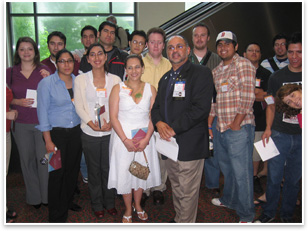
| The Shadow Knows Student mentoring program continue at the convention this year
Summary: Building on the successful mentor shadowing initiative that debuted at the AIA 2007 National Convention in San Antonio, the AIA is bringing the program to the national convention in Boston this May and establishing a protocol for making it an annual convention event. The initiative is spearheaded by the AIA Board of Directors, Diversity Committee, and the Young Architects Forum (YAF) to reach out to under-represented architecture students. Many Board members will participate as mentors. The success of the “shadow” program in San Antonio serves as a template for Boston and future AIA conventions. AIA Past President RK Stewart, FAIA, and current President Marshall Purnell, FAIA, requested that it become an annual convention event. The program kicked off with 55 minority architecture students from a junior college in San Antonio and three high school students from an inner city school under the leadership of 2007 Diversity Committee co-chairs John Padilla, AIA, and Clarence Kwan, AIA. In Boston, and at future conventions, Subcommittee Chair Kenneth Martin, AIA, NOMA, says the team is planning to expand the program to 75 students and 50 professionals. The mentor’s perspective She says the group sat in the second row at the general session—something she says she probably wouldn’t have done on her own—and then were like kids at a candy store on the Expo floor. “They went crazy,” she enthuses. By the time they got to the drafting presentations, the mentors just let the students park themselves and take in information about all the different technologies. “Pursuing a career in architecture is something they hadn’t considered before.” Now, she says, some of them are making a choice to focus their learning path on architecture education at their community or junior college. She notes one experience that sticks in her mind: One of the students was gazing at the sea of professionals in the general session, and asked the mentors, “So all these people are architects?” She said it was then she realized the profession needs to do a better job of marketing itself to young people. Building on success Like last year’s program, students also will have the opportunity to meet their mentors at an initial orientation session and then continue on to general session where the Whitney M. Young Jr. Award will be presented to Norma Sklarek, FAIA. Martin is working with some of the expo vendors to see if they can put together special presentations for the groups of students. Bourne says the format of going around in groups helped both the students, who could be comfortable with each other and not as shy as in one-on-one situation, and the mentors, who could also take advantage of the more informal setup. “The biggest thing that we wanted to have happen is have the students, being from an inner-city school and minority community, be eye-to-eye with architects who looked like them and see that there is a possibility of pursuing architecture as a career. I hope it will turn into a legacy program, done at every convention site,” Padilla told AIArchitect last year. Organizers are working very hard to grant that wish and promote the value of pursuing careers in architecture and related professions to underrepresented populations of the professional membership. |
||
Copyright 2008 The American Institute of Architects. All rights reserved. Home Page |
||
news headlines
practice
business
design
recent related
› Minority Architecture Students Shadow AIA Architects at Convention
› ACE Mentor Program Expands to Hershey, Pa.
For more information on becoming a mentor in Boston, email Yvette Morris, manager, Diversity, or call 202-626-7352.
John Padilla, AIA, center, during the 2007 Shadow an Architect event, decided to participate again at the 2008 convention in Boston.

 How do you . . .
How do you . . .